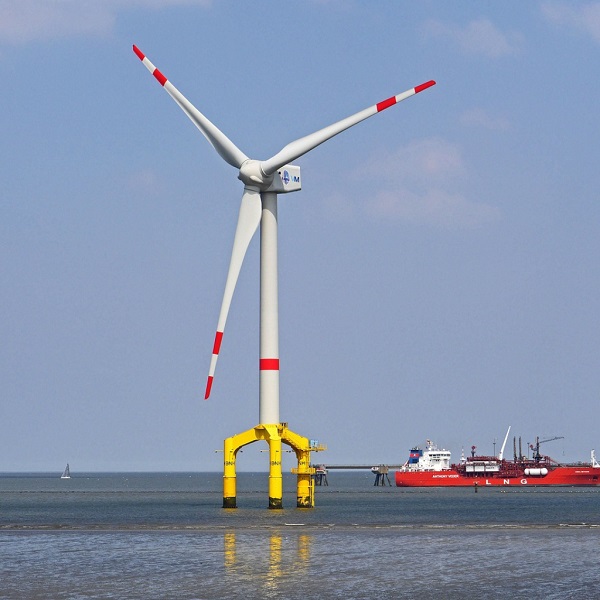During the energy crises of the 1970s, the founder of America’s first wind power engineering program told the United States Congress that wind turbines could eliminate America’s dependence on foreign energy. University of Massachusetts engineering professor William Heronemus foresaw turbines tapping the potent winds blowing offshore and using electrolysis of seawater to store their renewable power as hydrogen fuel.
Half a century later, Heronemus’ vision has sprouted sea legs. Platform technologies to float giant turbines are proliferating, expanding offshore wind power’s access to stronger winds over deeper waters. And in recent weeks, the first platform-based electrolysis plants have pushed offshore.
Countries are counting on offshore wind power’s abundance and hydrogen energy’s flexibility to meet energy security and climate goals, and combining the two technologies provides operational and cost advantages.
Last month a French hydrogen producer towed the world’s first floating hydrogen production platform to a test site 20 kilometers off the Normandy coast. Nantes-based Lhyfe began operating the 1-megawatt platform in the Port of Nantes Saint-Nazaire last year using shore power, producing 400 kilograms of renewable or green hydrogen per day. They are now poised to plug into a 2-MW floating wind turbine at France’s SEM-REV offshore energy test site.
And Chinese state media reported last week that researchers there had plugged a hydrogen production platform into a wind farm off the coast of Fujian Province. Nearly a dozen additional floating electrolysis demonstration projects are in the works in Japanese, European, and Scandinavian waters, according to one recent review.
What’s driving the interest in offshore hydrogen production, says Lhyfe offshore project manager Stéphane Le Berre, is risk-aversion and anticipated cost reductions. Countries are counting on offshore wind power’s abundance and hydrogen energy’s flexibility to meet energy security and climate goals, says Le Berre, and combining the two technologies provides operational and cost advantages.
This two-megawatt floating wind turbine at France’s SEM-REV offshore research site, designed by BW Ideol, is the forerunner for a one-gigawatt floating power plant to be installed in Scotland. Peter Fairley
European governments are already programming in combined offshore wind-plus-hydrogen developments. In January, Germany announced that it had designated space in its North Sea territorial waters for a green hydrogen project as large as 1-gigawatt. Two months later, the Dutch government said it would require bidders for a North Sea wind plant to include a 500-MW offshore electrolyzer.
During a visit to Lhyfe’s floating plant last month, shortly before it left the harbor, Le Berre told IEEE Spectrum that making hydrogen offshore is baked into Lhyfe’s mission. Lhyfe started producing hydrogen onshore in 2021, but that 1-MW electrolysis plant in coastal Normandy south of Nantes uses seawater from the local harbor. The Bouin plant’s water purification apparatus removes salt and other dissolved contaminants that would corrode the electrolyzer catalysts.
Last year Lhyfe raised €110 million ($118-million) in an initial public offering and accelerated its scale-up onshore. It now has three 5-MW plants under construction and is developing projects exceeding 100-MW in Denmark and Sweden.
To start moving offshore, says Le Berre, Lhyfe had to shrink equipment and boost reliability.
“A hydrogen production plant plus pipeline is five to ten times cheaper, as an investment, than an electric substation plus a cable.”
—Stéphane Le Berre, Lhyfe
Lhyfe’s offshore demonstrator repurposes an existing wave energy test platform with roughly 200-square-meters of open deck—a tight space for the electrolyzer, water purification plant and the transformer needed to use the 20-kilovolts from the SEM-REV test site’s floating wind turbine. Electrolyzer developer Latham, N.Y.-based Plug Power collaborated on a hardware redesign to make the equipment fit.
Tweaks to the electrolyzer’s control system, meanwhile, were needed to ensure proper operation amid the jostling expected at SEM-REV, where waves can exceed 13 meters. For example, sensors had to be recalibrated so the system would ride-through wave bumping but still shut down in the event of potentially dangerous internal gas-pressure spikes.
Preparing for the rigors of offshore operation drove proprietary upgrades to the water treatment as well—the component Lhyfe identified as the hydrogen platform’s weakest link.
Weather and competition for vessels can render access to offshore platforms difficult or impossible for weeks or months at a time, making monthly cleaning of reverse-osmosis filters untenable. So Lhyfe added technologies to both prevent and remove fouling. “We had to design the systems so that for approximately six months, there is no maintenance, no operations required,” says Le Berre.
Why go to all the trouble of producing hydrogen offshore in the first place? Why not just send the electricity ashore and produce hydrogen there?
For hydrogen suppliers, the offshore advantage is avoiding the cost and permitting delays associated with siting hydrogen production in densely-populated places like Europe and Japan. Le Berre adds that it took Lhyfe a year to line up an insurer willing to cover their first plant.
For offshore wind producers, meanwhile, Lhyfe projects that adding electrolysis and a hydrogen pipeline to shore will reduce the cost of delivering their energy as wind parks move further offshore. “A hydrogen production plant plus pipeline is five to ten times cheaper, as an investment, than an electric substation plus a cable,” says Le Berre.
Technology developments could boost hydrogen’s offshore advantage. The Chinese plant that started up this month uses a novel electrolyzer stack designed at the Chinese Academy of Sciences that eliminates the need for water treatment. The membrane-based technology, reported last year in Nature, spontaneously generates water vapor, selectively passes it towards the electrolysis cell, and re-liquefies it for separation by the catalyst.
Le Berre says Lhyfe isn’t waiting for improvements to plan its offshore scale-up. He says they already have a partner lined up for a 10-MW project on an offshore platform in Northern Europe—one that he promises to be able to “officially disclose” soon.
In the long term, Le Berre says Lhyfe hopes to return some benefit to the ocean. Splitting seawater to make hydrogen also releases an equal quantity of oxygen, which is deficient in many coastal waters due to sewage and fertilizer runoff. According to Le Berre countering such oxygen dead-zones drove Lhyfe’s launch in 2019: ”We want the ocean to actually keep as much of this oxygen as possible.”
Source: Spectrum










